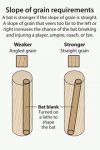If you look at recommendation #3 in the article YOU linked to you will see that it backs up exactly what I said: "3. The orientation of the hitting surface on sugar maple and maple bats should be rotated 90 degrees (one-quarter turn of the bat). The edge grain in maple that is currently used as the hitting surface is the weaker of the two choices. To facilitate such a change in the hitting surface, manufacturers must rotate the logos they place on these bats by 90 degrees."
Maybe there is a remedial class in reading English at some local community college you can take????
The run-out of grain over the length of a handle or bat AND the orientation of the grain with or perpendicular to the direction of travel are two completely different subjects. Everyone knows that you want minimum or no run-out over the length of the handle or bat, but the grain orientation in relation to the direction of travel can work on edge or on face depending on the type of wood......
The study also says that bats usually break when struck about ten-inches from the end, and if you apply this to axes it means that usually the reason an axe breaks is that some noob has missed with his swing and has the handle hitting the target instead of the axe-head itself.
So all the controversy on this board about grain orientation is mostly hog-wash because if you take the type of wood the handle is made of into account it can mean the grain should be rotated ninety degrees from where it would be if the handle were of another type of wood, and it probably will not make any difference anyway because if the user is a noob and is going to strike the handle on his target a lot he is going to break the handle very quickly no matter how it is made or what type of wood it is....
The actual study that the article refers to is available as a pdf. download here and is much more complete and informative for those who take time to read it slowly and understand it:
http://ac.els-cdn.com/S187770581201...t=1498568672_83780af876a2aa7f6a4c82d543bafde1
I corrected you a page ago when you claimed this claptrap, and I will do so again.
You have zero point of reference. You jumped on to the end of the maple bat mlb stories and think you have found something. Well, you are wrong in the way you apply what you read.
It starts with the experts checking every single broken bat from the entire 2008 season. And those experts declared soundly that the majority of broken bats are from poor grain orientation and manufacturing defects.
Then they discovered that the drop weight of maple is harder to go into the desired -3 ish area. They were making the handles too thin.
They were over drying the maple. Making it weaker. And on. And on.
You are clinging to one part of the TOTAL PACKAGE that mlb uses to have less two piece/ breaks in maple.
Maple is nothing like hickory.
Hickory is more like ash.
The fact that maple(any wood) is stronger in impact strike better on the face than it is on the end grain is a poor argument. It really does not apply to your claim of ax handles.
Those impact tests on wood are done with both ends clamped down tight and it is struck in the middle. That is not how a bat or an ax handle take force to fail. That is why baseball bat testing is done with only one end held in rollers so it can move.
YOU HIT WITH ASH AGAINST THE END GRAIN!
YOU HIT WITH HICKORY AGAINST THE END GRAIN!
BOTH WOODS ARE POROUS. BOTH WILL EXPERIENCE DELAMINATION. THE LAYERS WILL SEPERATE UNDER STRESS AND STRIKE!
The reason hickory is not used for bats is because it is heavy. Worse than the maple. And you only get like 10% out of the wood worthy of a bat.
Maple also a get low of useable wood. They were just using it all at the beginning. Now there are standards.
You don't hit Ash against the face because it will crack and experience delamination and flaking.
It is the same for hickory.
If a maple bat is properly made it does not matter where you oriented the grain. On a properly made and selected maple bat hitting on the face grain will lessen the chances of a catastrophic two piece failure.
Try doing all the research. All handles in the hardware store are hickory. So all this "controversy" as you put it is not for nothing. Most axes you see on this forum have hickory handles. Hickory and ash SHOULD have to be oriented with the end grain towards the strike. For multiple reasons.












